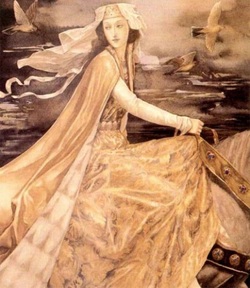Fae Folk History

The fae folk have been around for millennia. Folklorists have surmised that these creatures stemmed not only from legendary figures, but that they were also based on perspective differences between different cultures. The Persian myths referred to creatures such as "Peris," or "Peri," which are described as creatures that have come from the sky. After seeing the pale-skinned peoples of the north, perhaps the Persians saw the Nordic and the Slavic as Peri. This might also be true for the reverse. The Vikings speak of the "Feen" or the "Feinin," roughly translating to "Fair Ones." Then there is also the Sidhe, the "Hill People." The Sidhe, in some accounts, were also referred to as the Picts. So if you are in any way curious to know where the term "faery" or "pixie" even began to take fruit, you might start there.
"Rhiannon" by Alan Lee above picture
Faeries stemmed from legends and mythology. The Welsh--particularly that of the Mabinogion (a collection of Welsh lore mixed with Arthurian-based stories)--speak of the goddess Rhiannon, whose presence can be akin to that of the Faery Queen Morgan le Fay from the Arthurian legends. In Ireland, the mythical people of the Tuatha Dé Danann were thought to be the fae folk because they worshiped the Goddess, or the Faery Queen (technically, the name translates to "peoples of the goddess Danu," but this has since been believed incorrect since Danu isn't the name of the goddess that they worship).
By the Middle Ages, pagan beliefs--and therefore beliefs in the supernatural faery world--were becoming less and less condoned. Gone were the superstitions about the Seven Year King, the strange blood rituals, and the fear of the Wild Hunt. Instead, majority-Christian Europe typified faeries as shameful, not-so-powerful creatures cast out from heaven. Because the faeries did not pick a side between heaven and hell, they were cast down as fallen angels, and were banished to the mortal realms to live out their punishment. The faeries live with the humans, but as fallen angels go, they exist in a parallel plane, in the faery world, hidden from mortal eyes.
Faeries were always believed to be either good or bad. Up until the 15th century, the classification of the fae folk was usually limited to whether they were evil spirits or benevolent ones. It wasn't until the good ole' 15th century where alchemist Paracelsus moved to classify the fae folk into four categories: air (sylphs), earth (gnomes), fire (salamanders), and water (undines).
The depictions of the cute, tiny creatures with wings were mostly created from the Victorian era until the present day. Older accounts would have seen faeries looking like ethereal humans--more beautiful and absolutely more deadly, of course. But Victorian literature and artwork have managed to change that. Sir Arthur Conan Doyle has depicted faeries as the small pixies that they are now generally known to be. Artist Arthur Rackham also drew faeries as these small creatures, and subsequently, many other artists took the same path.
To Learn More Fey History Go Here

No comments:
Post a Comment